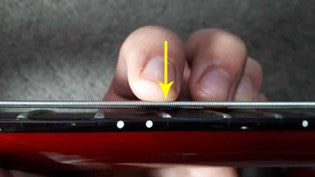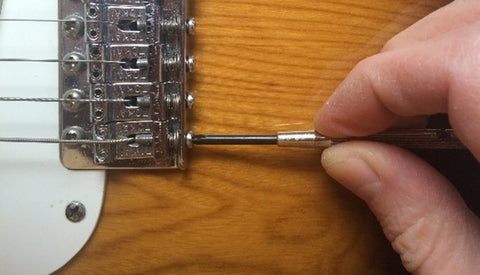A Guide to Steel-String Ukulele Intonation.
By Ukulele Trading Co. Australia, Ver 2_1023
How do I know if my steel-string ukulele needs intonation?
If your Steel String Ukulele sounds a bit wonky when you play certain chords
A. You may need to adjust your playing technique or
B. Adjust the intonation of your instrument.
Intonation adjustments are made by adjusting the position of your bridge saddles to either lengthen or shorten the scale length of the string. You will be moving the saddle closer or farther from the rear of the bridge. But maybe it isn’t an intonation problem at all, how do you check?
A. You may need to adjust your playing technique
Ask yourself "if your wonky sounding chords and notes may be due to your left hand fretting technique?"
This question is not a slight on your skill level or ability, but rather the knowledge that when playing a Steel-string Ukulele, a new lighter approach is needed to your playing technique.
You will re-learn how you play your instrument, especially how you fret your instrument. Right-hand electric techniques are for another article.
Electric steel string players can play fast because they hardly touch the strings, their left hand glides over the fretboard.
Having much lighter strings on a steel string electric than a traditional acoustic ukulele, you need only press down lightly to get the string to contact the top of the fret.
Moving from a traditional acoustic ukulele to a steel string electric ukulele, it is very similar to Acoustic guitar players switching to Electric guitar.
Acoustic ukuleles demand a strong left hand to form chord shapes.
Steel String Electric ukuleles demand a very light touch with your left hand.
Acoustic strings are heavier, and thicker and offer much more resistance to being pressed down to form chords. Acoustic instruments really give your left hand and fingers a good workout.
Steel-string electric ukes and electric guitars do not require nearly the same force to push the strings down. When making the change Acoustic players are at first too heavy-handed and strangle the living daylights out of their steel-string electric, they often ‘overplay’ the instrument.
So, beware of pressing down too hard on the strings, this drives the strings note sharp as you stretch the string. Light contact between the Steel string and the Fret top is all that is needed, the magnetic pickups will do the heavy lifting and create the volume.
And be very careful you are not pushing your strings to the side; this also will drive the notes/chords sharp.
Your Fingering Technique is very important with a steel string ukulele, you need to come down directly on top of the string with your fingertip and not push the string sideways.
B. Adjust the intonation of your instrument.
Intonation is checked at the 12th Fret Harmonic note and not at the individual frets along the ukulele fretboard.
You want the open and octave notes at the 12th fret to be the same note just one octave apart, or as similar as possible, at least withing two or three 'bars' on your tuner. You should play a Harmonic note over the 12th fret and compare that to the Open string note.
INTERESTING FACT; Did you know most humans do not have perfect pitch as perfect pitch is quite rare. Most people can only notice differences in pitch to about 10 cents, with there being 100 cents to each semitone. Any two notes on your fretboard are 1 semitone apart, or 100 cents apart.
You will certainly improve your detection of pitch with more playing hours under your belt. Or if you want to fast track your brain/ear connection then seek out and do Pitch Training exercies, suh as learning to play by ear, tune by ear, or even simple auditory games such as the "Higher or Lower or the Same" will help.
How to Play a 12th Fret Natural Harmonic
The easiest way to check your steel string ukulele’s intonation is to compare the pitch of the fretted 12th fret note to a 12th fret natural harmonic.
To play a natural harmonic on the 12th fret, lightly touch your steel string ukulele string directly above the 12th fret of the strings.
Don’t push down on the string; only lightly touch it. The string should not press against the fret. As soon as you have picked the note, the finger lifts off the string to let the note ring. It will sound like a very high note; it is 1 octave above the open note.
With your tuner still on, check the tuning of the 12th fret harmonic. It should be perfectly in tune, with the open note.
It will, of course, be an octave higher, as the frequency of the note will be double that of the open note frequency. i.e. The Open A string note is vibrating at 440 Hertz, the harmonic note at the 12th fret will be double that, 880 Hz.

Getting Hands-On
Which way do I move my saddle for intonation?
If the fretted note is different from the harmonic, you'll need to adjust the saddle. Unsure of which way to move the saddle? No problem: if the fretted note is sharp, move the saddle backward (away from the neck); if the fretted note is flat, move the saddle forward (towards the neck).
Remember the 3 F Rule: If the Fretted note is Flat, move the saddle Forward.
Using an accurate tuner; If the string is found to be in tune both when played open and when sounding its 12th-fret harmonic, then your string is correctly intonated, and you’re in good shape. The string is in tune “with itself.” Move onto the next string.
If, however, there’s a tuning discrepancy between the fretted 12th-fret note and the 12th-fret harmonic, the string is not correctly intonated and requires adjustment. In that case, the fretted 12th-fret note will sound either sharp or flat compared to the 12th-fret harmonic.
Before moving a Bridge saddle, always Loosen your string .
If you do not loosen the string then the string saddle will be held in place by the strings pressure and you will probably strip the head of the adjusting saddle, and you will scratch the top plate of the bridge removing the chrome plating.
Loosen the string to slack, this removes the tension, and then you can use a screwdriver to move the saddle forward/backward as required.
Use a small Philips head screwdriver to turn the adjustment screw and move the saddle.

Rember: Righty Tighty and Lefty Loosey.
Tightening the screw clockwise (righty) will move the saddle further back towards the rear of the bridge lengthening the string scale. Turning anti-clockwise (loosey) will move the saddle closer towards the pickups shortening the scale length of the string.
HINT I normally move a saddle approx 2 mm at a time. Then retighten the slack string and tune it up till the open note is correct. Then compare it with the 12th fret harmonic note to check what the adjustment has done. If more is required, then slacken the string and repeat the process.
SUMMARY
Wonky intonation isn’t unusual, wonky intonation isn’t uncommon; in fact, it is expected.
Steel-string ukuleles are machines, after all, and machines require periodic maintenance, especially when moving climates (interstate travel) and when string are new.
Your steel string ukulele is subject to environmental conditions that alter its intonation. Fluctuations in intonation are exactly why quality steel string ukuleles are designed with adjustable bridge saddles as intonation mechanisms.
Even under normal circumstances, periodic intonation checks and adjustments are necessary, and it is in fact one of the main elements of a proper setup.





